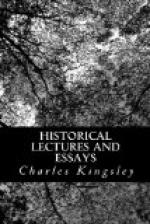And so grew up again in Europe a passion for what were called the Occult sciences. It had always been haunting the European imagination. Mediaeval monks had long ago transformed the poet Virgil into a great necromancer. And there were immense excuses for such a belief. There was a mass of collateral evidence that the occult sciences were true, which it was impossible then to resist. Races far more ancient, learned, civilised, than any Frenchman, German, Englishman, or even Italian, in the fifteenth century had believed in these things. The Moors, the best physicians of the Middle Ages, had their heads full, as the “Arabian Nights” prove, of enchanters, genii, peris, and what not? The Jewish rabbis had their Cabala, which sprang up in Alexandria, a system of philosophy founded on the mystic meaning of the words and the actual letters of the text of Scripture, which some said was given by the angel Ragiel to Adam in Paradise, by which Adam talked with angels, the sun and moon, summoned spirits, interpreted dreams, healed and destroyed; and by that book of Ragiel, as it was called, Solomon became the great magician and master of all the spirits and their hoarded treasures.
So strong, indeed, was the belief in the mysteries of the Cabala, that Reuchlin, the restorer of Hebrew learning in Germany, and Pico di Mirandola, the greatest of Italian savants, accepted them; and not only Pope Leo X. himself, but even statesmen and warriors received with delight Reuchlin’s cabalistic treatise, “De Verbo Mirifico,” on the mystic word “Schemhamphorash”—that hidden name of God, which whosoever can pronounce aright is, for the moment, lord of nature and of all daemons.
Amulets, too, and talismans; the faith in them was exceeding ancient. Solomon had his seal, by which he commanded all daemons; and there is a whole literature of curious nonsense, which you may read if you will, about the Abraxas and other talismans of the Gnostics in Syria; and another, of the secret virtues which were supposed to reside in gems: especially in the old Roman and Greek gems, carved into intaglios with figures of heathen gods and goddesses. Lapidaria, or lists of these gems and their magical virtues, were not uncommon in the Middle Ages. You may read a great deal that is interesting about them at the end of Mr. King’s book on gems.
Astrology too; though Pico di Mirandola might set himself against the rest of the world, few were found daring enough to deny so ancient a science. Luther and Melancthon merely followed the regular tradition of public opinion when they admitted its truth. It sprang probably from the worship of the Seven Planets by the old Chaldees. It was brought back from Babylon by the Jews after the Captivity, and spread over all Europe—perhaps all Asia likewise.
The rich and mighty of the earth must needs have their nativities cast, and consult the stars; and Cornelius Agrippa gave mortal offence to the Queen-Dowager of France (mother of Francis I.) because, when she compelled him to consult the stars about Francis’s chance of getting out of his captivity in Spain after the battle of Pavia, he wrote and spoke his mind honestly about such nonsense.




